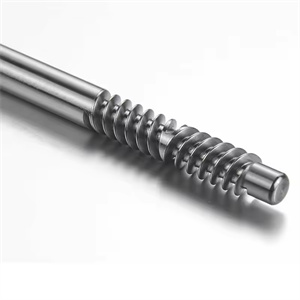Machining and producing worm shafts is a process with high precision requirements. Worm shafts play an important role in mechanical transmission and are commonly used in equipment such as reduction devices. In terms of material selection, high-quality alloy steels such as 40Cr or 42CrMo are usually selected to ensure their strength and wear resistance. The manufacturing of blanks is generally improved by forging to improve the internal structure of materials and enhance their mechanical properties.
The machining process mainly includes the following key steps:
Turning: Turning the blank to preliminarily form the shape of the worm shaft, including the shaft diameter, shoulder, and other parts.
Milling worm threads: This is the core process of worm shaft machining. Use specialized worm milling cutters to accurately mill worm threads according to the designed parameters.
During the milling process, it is necessary to strictly control the lead, tooth shape, and accuracy of the thread. For example, in the machining of high-precision worm shafts, multiple tool passes and fine tool adjustments may be required to ensure that the thread accuracy reaches the micrometer level.
Grinding: For worm shafts with high precision requirements, grinding will be carried out to improve the surface roughness and dimensional accuracy of the shaft.
Drilling and tapping: Processing holes and threads for installation and fixation.
During the machining process, it is necessary to ensure that the coaxiality, straightness, and other geometric tolerances of the worm shaft meet the requirements.
Heat treatment is also an important step, usually undergoing quenching, tempering and other treatments to improve the hardness and toughness of the worm shaft.
In terms of quality inspection, precision equipment such as coordinate measuring instruments and gear measuring instruments will be used to detect various dimensional parameters, thread accuracy, surface quality, etc. of the worm shaft. The accuracy and quality of the worm shaft in large-scale industrial reducers directly affect the transmission efficiency and stability of the reducer.
In short, machining and producing worm shafts requires advanced equipment, exquisite craftsmanship, and strict quality control to meet the high-performance requirements of mechanical transmission systems.
Shafts are mechanical components composed of one or more slender rods, mainly used in transmission mechanical systems. They can be individual rods or composite rods composed of multiple rods. Shafts play a crucial role in transmitting power and torque in mechanical equipment, typically used to connect two or more rotating components such as gears, pulleys, etc. The structure of Shafts can be divided into three types: single rod, composite rod, and composite multi rod.
In CNC machining, precise machining of Shafts is crucial for ensuring the performance of mechanical equipment. CNC machining can achieve high-precision machining, ensuring that the size, shape, and accuracy of Shafts meet design requirements, thereby improving the overall performance and service life of mechanical equipment.
If the shape of the Shafts is relatively simple, mainly cylindrical or with rotational symmetry planes, then CNC Turning may be a better choice. If Shafts have complex shapes and features, then CNC Milling may be more suitable. In addition, factors such as material processability, processing costs, and production efficiency need to be considered to select the most suitable processing method.
